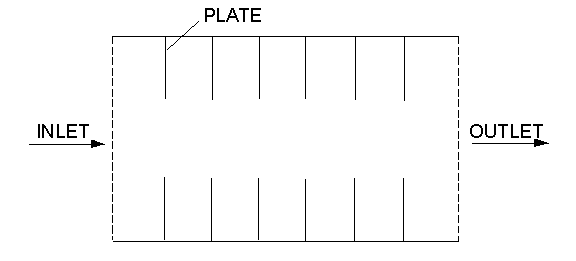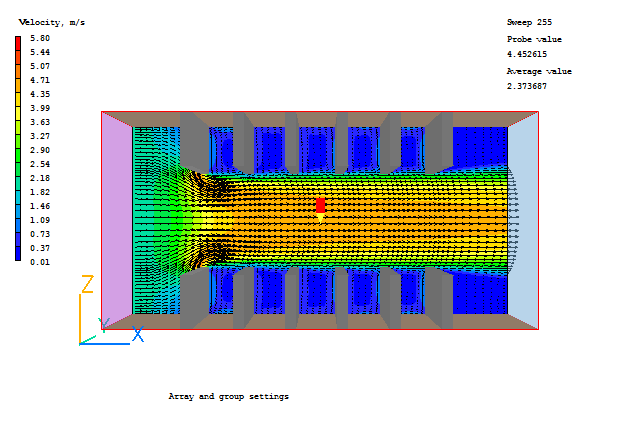
This workshop demonstrates how to set up a geometry with the Array and Group facility of the VR Editor, and to run the simulation. The flow is two-dimensional and its geometry is shown in the figure below.
Velocity and pressure will be solved.

From the system level:
To enter the PHOENICS-VR environment, click on the PHOENICS icon on the desktop, or click on Start, programs, PHOENICS, PHOENICS.
In PHOENICS-VR environment:
Start with an 'empty' case - click on 'File' then on 'Start New Case', then on 'Core', then click on 'OK'; to confirm the resetting.
To enter VR Editor:
This is the default mode of operation.
Set the domain size and activate solution of required variables:
Click on 'Main Menu' and then on 'Geometry'.
Change the X-Domain Size to 2.00 m.
Click 'OK' to close the Grid mesh settings dialog.
Click on 'Models'.
Leave the 'solution for velocities and pressure' ON.
Select the LVEL Turbulence model in 'Turbulence Models'.
Set the boundary conditions on the domain faces:
Click on 'Domain Faces'.
Set 'Wall' to 'Yes' for the Zmin and Zmax faces.
Set 'Flow' to 'Yes' for the Xmin face.
Click 'Settings' for the Xmin face.
Set the velocity to 2.00 m/s in the X-Direction.
Click on 'OK' to exit from the Object Dialogue Box.
Set 'Open' to 'Yes' for the Xmax face.
Click on 'OK' to exit from the Domain faces Dialogue Box, and 'OK' again to close the reminder to set / check boundary conditions. The default settings are fine.
Click on 'OK' to close the Main Menu.
Click on 'Reset' button and then 'Fit to window'/'OK'.
Create the first plate blockage object:
Click on 'Settings', 'New' and 'New Object'. Select Type: Blockage.
Change name to BLOCK1 (which stands for first blockage).
Click on 'Size' and set size of the object as:
Xsize: 0.05
Ysize: 1.0
Zsize: 0.25
Click on 'Place' and set Position of the object as:
Xpos: 0.36
Ypos: 0.0
Zpos: 0.0
Click on 'General'.
Click on 'OK' to exit from the Object Dialogue Box.
Create 5 copies of BLOCK1 along the lower surface using the arraying feature:
Click on the 'Duplicate using array' button
on the handset.
Set Dimension and Pitch as:
Direction Dimension Pitch X: 6 0.24 Y: 1 0.0 Z: 1 0.0 The 'Offsets' boxes should all be left at 0.0.
Click on 'OK'.
We now turn the 6 blocks (original + 5 copies) into a group, and copy the group to make the upper six blocks.
Click on the 'Object management' button on the handset (
) or
on the toolbar.
Select 6 blockages (BLOCK1, B6,B7,B8,B9,B10).
Click on 'Group' and 'Save'. This will create a new object B11 with all 6 blockages added (Type is Group).
Click on 'Duplicate object or Group' button and 'OK'
on the handset
Move the newly created group to Zpos = 0.75 on the handset.
Close the object management dialog box.
Set the grid:
Click on the 'Mesh toggle' button. The default mesh (shown as blue and orange lines) will appear on the screen. The orange lines are 'regions', defined by the bounding boxes of the objects. This mesh (64 in X, 52 in Z) is adequate for this tutorial. Click on 'Mesh toggle' again to turn off the mesh display.
Set the remaining solution control parameters:
Click on 'Main Menu' and then on 'Numerics'.
Set the number of iteration to 300.
Click on 'Top menu' to return to the top menu.
Click on 'OK' to exit the Main Menu.
Click on the probe icon
on the toolbar or double-click the probe itself, and move the probe to X=1.0, Y=0.5, Z=0.5.
In the PHOENICS-VR environment, click on 'Run', 'Solver' (Earth), and click on 'OK'; to confirm running Earth.
In the PHOENICS-VR environment, click on 'Run', 'Post processor',then GUI Post processor (VR Viewer) . Click 'OK' on the file names dialog to accept the default files.
To view:
To select the plotting variable:
To change the direction of the plotting plane, set the slice direction to X, Y or Z ![]()
To change the position of the plotting plane, move the probe using the probe position buttons

A typical plot from this case is:

In the PHOENICS-VR environment, click on 'Save as a case', make a new folder called 'ARRAYS' (e.g.) and save as 'CASE1' (e.g.).